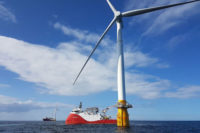As workers struggle to remove remnants of Hanford’s old industrial mission, construction of a $12.3-billion state-of-the-art waste-treatment plant symbolizes its future. If construction officials master cost, schedule and technology challenges, the vitrification plant will restore production to the site and offer the region an economic boost.


The multibuilding, 65-acre vitrification complex will receive nuclear and chemical waste from aging underground tanks, remove water and solids and mix the remainder with molten glass to produce hard logs. Low-level radioactive logs will be disposed of onsite; high-level logs will eventually go to the Yucca Mountain repository in Nevada.
The Hanford facility will be the world’s largest mixed-waste treatment plant, with the capacity to produce 36 metric tons of vitrified waste daily. It is being built by Bechtel Group Inc., with a total current workforce of more than 3,500 people, on site and in three company offices in the U.S.
Craft labor now totals 900 workers in 18 trades but won’t reach its peak until 2014, says Delmar L. Noyes, U.S. Energy Dept. deputy project manager. The job has 300 subcontractors, but “it’s a challenge getting vendors to bid,” he says. “We have to mentor firms to meet quality requirements.”
Bechtel ticks off the project’s material demands: 257,000 cu yd of concrete, 34,600 tons of structural steel, 187 miles of piping and 800 miles of electrical cable. “For the amount of commodity we’re installing, it takes a lot of front-end paperwork to ensure it all goes in correctly and on time,” says Mike Martinez, Bechtel lead field welding engineer. “Many eyes are on us.” He says the plant will have 65,000 engineered welds in its piping system alone and is being designed for a 40-year life-span.
The pressure is on for a project whose completion affects other site activities and which has doubled in cost since the first bid early in the decade. Some construction work was delayed two years because of seismic design and technology concerns.
Halting work on the critical pretreatment building, which will separate waste streams, and on the high-level treatment facility has the project at 45% completion, says Noyes. Officially, it will operate in 2019, but waste treatment may start two years earlier. Full-scale operation was once targeted for 2011. Bechtel says it has resolved 24 design issues from a 2006 review by a team of outside industry experts, but others may require two million more engineering hours.
Although many plant functions will be remotely operated for safety, the operations workforce will be at least 1,000, says Noyes. The site is already a sea of hard hats, each color-coded by job function in an ever-tightening work space.





